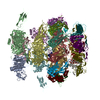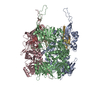[English] 日本語
 Yorodumi
Yorodumi- PDB-7zqp: Tail tip of siphophage T5 : open cone after interaction with bact... -
+ Open data
Open data
- Basic information
Basic information
| Entry | Database: PDB / ID: 7zqp | |||||||||
|---|---|---|---|---|---|---|---|---|---|---|
| Title | Tail tip of siphophage T5 : open cone after interaction with bacterial receptor FhuA | |||||||||
 Components Components |
| |||||||||
 Keywords Keywords | VIRAL PROTEIN / Bacteriophage / Siphophage / T5 / baseplate | |||||||||
| Function / homology |  Function and homology information Function and homology informationpeptidoglycan muralytic activity / : / symbiont entry into host cell via disruption of host cell wall peptidoglycan / symbiont genome ejection through host cell envelope, long flexible tail mechanism / virus tail, baseplate / symbiont entry into host cell via disruption of host cell envelope / viral tail assembly / virus tail / symbiont entry into host / symbiont genome entry into host cell via pore formation in plasma membrane ...peptidoglycan muralytic activity / : / symbiont entry into host cell via disruption of host cell wall peptidoglycan / symbiont genome ejection through host cell envelope, long flexible tail mechanism / virus tail, baseplate / symbiont entry into host cell via disruption of host cell envelope / viral tail assembly / virus tail / symbiont entry into host / symbiont genome entry into host cell via pore formation in plasma membrane / killing of cells of another organism / defense response to bacterium / lyase activity Similarity search - Function | |||||||||
| Biological species |  Escherichia phage T5 (virus) Escherichia phage T5 (virus) | |||||||||
| Method | ELECTRON MICROSCOPY / single particle reconstruction / cryo EM / Resolution: 3.6 Å | |||||||||
 Authors Authors | Linares, R. / Arnaud, C.A. / Effantin, G. / Darnault, C. / Epalle, N. / Boeri Erba, E. / Schoehn, G. / Breyton, C. | |||||||||
| Funding support |  France, 2items France, 2items
| |||||||||
 Citation Citation |  Journal: Sci Adv / Year: 2023 Journal: Sci Adv / Year: 2023Title: Structural basis of bacteriophage T5 infection trigger and cell wall perforation. Authors: Romain Linares / Charles-Adrien Arnaud / Grégory Effantin / Claudine Darnault / Nathan Hugo Epalle / Elisabetta Boeri Erba / Guy Schoehn / Cécile Breyton /  Abstract: Most bacteriophages present a tail allowing host recognition, cell wall perforation, and viral DNA channeling from the capsid to the infected bacterium cytoplasm. The majority of tailed phages bear a ...Most bacteriophages present a tail allowing host recognition, cell wall perforation, and viral DNA channeling from the capsid to the infected bacterium cytoplasm. The majority of tailed phages bear a long flexible tail () at the tip of which receptor binding proteins (RBPs) specifically interact with their host, triggering infection. In siphophage T5, the unique RBP is located at the extremity of a central fiber. We present the structures of T5 tail tip, determined by cryo-electron microscopy before and after interaction with its receptor, FhuA, reconstituted into nanodisc. These structures bring out the important conformational changes undergone by T5 tail tip upon infection, which include bending of T5 central fiber on the side of the tail tip, tail anchoring to the membrane, tail tube opening, and formation of a transmembrane channel. The data allow to detail the first steps of an otherwise undescribed infection mechanism. | |||||||||
| History |
|
- Structure visualization
Structure visualization
| Structure viewer | Molecule:  Molmil Molmil Jmol/JSmol Jmol/JSmol |
|---|
- Downloads & links
Downloads & links
- Download
Download
| PDBx/mmCIF format |  7zqp.cif.gz 7zqp.cif.gz | 479.7 KB | Display |  PDBx/mmCIF format PDBx/mmCIF format |
|---|---|---|---|---|
| PDB format |  pdb7zqp.ent.gz pdb7zqp.ent.gz | 346.9 KB | Display |  PDB format PDB format |
| PDBx/mmJSON format |  7zqp.json.gz 7zqp.json.gz | Tree view |  PDBx/mmJSON format PDBx/mmJSON format | |
| Others |  Other downloads Other downloads |
-Validation report
| Summary document |  7zqp_validation.pdf.gz 7zqp_validation.pdf.gz | 1.3 MB | Display |  wwPDB validaton report wwPDB validaton report |
|---|---|---|---|---|
| Full document |  7zqp_full_validation.pdf.gz 7zqp_full_validation.pdf.gz | 1.3 MB | Display | |
| Data in XML |  7zqp_validation.xml.gz 7zqp_validation.xml.gz | 61.4 KB | Display | |
| Data in CIF |  7zqp_validation.cif.gz 7zqp_validation.cif.gz | 94.2 KB | Display | |
| Arichive directory |  https://data.pdbj.org/pub/pdb/validation_reports/zq/7zqp https://data.pdbj.org/pub/pdb/validation_reports/zq/7zqp ftp://data.pdbj.org/pub/pdb/validation_reports/zq/7zqp ftp://data.pdbj.org/pub/pdb/validation_reports/zq/7zqp | HTTPS FTP |
-Related structure data
| Related structure data |  14873MC  7qg9C  7zhjC  7zlvC  7zn2C  7zn4C  7zqbC M: map data used to model this data C: citing same article ( |
|---|---|
| Similar structure data | Similarity search - Function & homology  F&H Search F&H Search |
- Links
Links
- Assembly
Assembly
| Deposited unit | 
|
|---|---|
| 1 |
|
- Components
Components
| #1: Protein | Mass: 107279.766 Da / Num. of mol.: 3 / Source method: isolated from a natural source / Source: (natural)  Escherichia phage T5 (virus) / References: UniProt: Q6QGE9 Escherichia phage T5 (virus) / References: UniProt: Q6QGE9#2: Protein | Mass: 131639.578 Da / Num. of mol.: 3 / Source method: isolated from a natural source / Source: (natural)  Escherichia phage T5 (virus) / References: UniProt: Q6QGE7 Escherichia phage T5 (virus) / References: UniProt: Q6QGE7Has protein modification | Y | |
|---|
-Experimental details
-Experiment
| Experiment | Method: ELECTRON MICROSCOPY |
|---|---|
| EM experiment | Aggregation state: PARTICLE / 3D reconstruction method: single particle reconstruction |
- Sample preparation
Sample preparation
| Component | Name: Escherichia virus T5 / Type: VIRUS Details: Pure T5 tails obtained by infecting E. coli F strain with the amber mutant phage T5D20am30d, incubated with E. coli receptor FhuA reconstituted into nanodisc Entity ID: all / Source: NATURAL | |||||||||||||||||||||||||
|---|---|---|---|---|---|---|---|---|---|---|---|---|---|---|---|---|---|---|---|---|---|---|---|---|---|---|
| Molecular weight | Experimental value: NO | |||||||||||||||||||||||||
| Source (natural) | Organism:  Escherichia virus T5 Escherichia virus T5 | |||||||||||||||||||||||||
| Details of virus | Empty: NO / Enveloped: NO / Isolate: STRAIN / Type: VIRUS-LIKE PARTICLE | |||||||||||||||||||||||||
| Natural host | Organism: Escherichia coli / Strain: F | |||||||||||||||||||||||||
| Buffer solution | pH: 8 | |||||||||||||||||||||||||
| Buffer component |
| |||||||||||||||||||||||||
| Specimen | Embedding applied: NO / Shadowing applied: NO / Staining applied: NO / Vitrification applied: YES Details: Pure T5 tails obtained by infecting E. coli F strain with the amber mutant phage T5D20am30d, incubated with E. coli receptor FhuA reconstituted into nanodisc | |||||||||||||||||||||||||
| Specimen support | Details: intensity 25 mA / Grid material: COPPER/RHODIUM / Grid mesh size: 300 divisions/in. / Grid type: Quantifoil R2/1 | |||||||||||||||||||||||||
| Vitrification | Instrument: FEI VITROBOT MARK IV / Cryogen name: ETHANE / Humidity: 100 % / Chamber temperature: 293.15 K Details: 3 uL of T5 tails sample (with or without FhuA-ND) were deposited on a freshly glow discharged EM grid and plunge-frozen in nitrogen-cooled liquid ethane using a ThermoFisher Mark IV Vitrobot ...Details: 3 uL of T5 tails sample (with or without FhuA-ND) were deposited on a freshly glow discharged EM grid and plunge-frozen in nitrogen-cooled liquid ethane using a ThermoFisher Mark IV Vitrobot device (100 percent humidity, 20 Celsius degrees, 5 s blotting time, blot force 0) |
- Electron microscopy imaging
Electron microscopy imaging
| Experimental equipment |  Model: Titan Krios / Image courtesy: FEI Company |
|---|---|
| Microscopy | Model: FEI TITAN KRIOS |
| Electron gun | Electron source:  FIELD EMISSION GUN / Accelerating voltage: 300 kV / Illumination mode: FLOOD BEAM FIELD EMISSION GUN / Accelerating voltage: 300 kV / Illumination mode: FLOOD BEAM |
| Electron lens | Mode: BRIGHT FIELD / Nominal magnification: 105000 X / Nominal defocus max: 3000 nm / Nominal defocus min: 1000 nm / Cs: 2.7 mm |
| Specimen holder | Cryogen: NITROGEN / Specimen holder model: FEI TITAN KRIOS AUTOGRID HOLDER |
| Image recording | Electron dose: 40 e/Å2 / Detector mode: COUNTING / Film or detector model: GATAN K2 SUMMIT (4k x 4k) |
| Image scans | Movie frames/image: 40 |
- Processing
Processing
| EM software |
| ||||||||||||||||||||||||||||||||
|---|---|---|---|---|---|---|---|---|---|---|---|---|---|---|---|---|---|---|---|---|---|---|---|---|---|---|---|---|---|---|---|---|---|
| CTF correction | Type: PHASE FLIPPING AND AMPLITUDE CORRECTION | ||||||||||||||||||||||||||||||||
| Symmetry | Point symmetry: C3 (3 fold cyclic) | ||||||||||||||||||||||||||||||||
| 3D reconstruction | Resolution: 3.6 Å / Resolution method: FSC 0.143 CUT-OFF / Num. of particles: 20349 / Symmetry type: POINT | ||||||||||||||||||||||||||||||||
| Atomic model building | Protocol: BACKBONE TRACE / Space: REAL |
 Movie
Movie Controller
Controller








 PDBj
PDBj